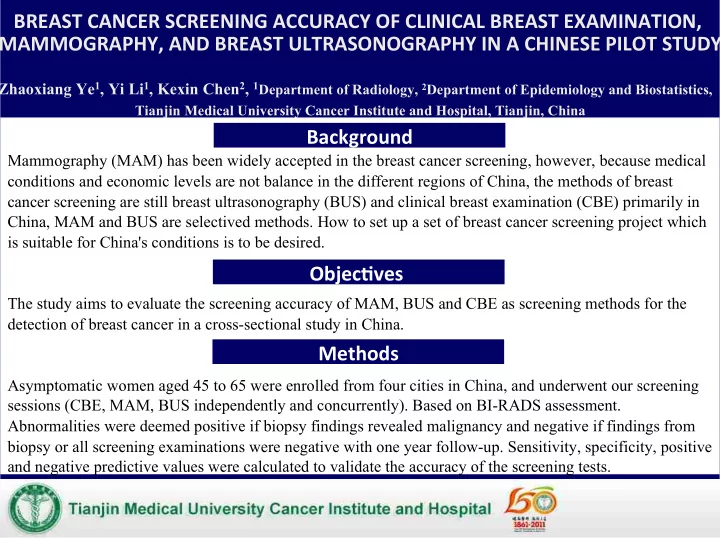

BREAST'CANCER'SCREENING'ACCURACY'OF'CLINICAL'BREAST'EXAMINATION,' MAMMOGRAPHY,'AND'BREAST'ULTRASONOGRAPHY'IN'A'CHINESE'PILOT'STUDY ' Zhaoxiang Ye 1 , Yi Li 1 , Kexin Chen 2 , 1 Department of Radiology, 2 Department of Epidemiology and Biostatistics, ! ! Tianjin Medical University Cancer Institute and Hospital, Tianjin, China ! Background � ! Mammography (MAM) has been widely accepted in the breast cancer screening, however, because medical conditions and economic levels are not balance in the different regions of China, the methods of breast cancer screening are still breast ultrasonography (BUS) and clinical breast examination (CBE) primarily in China, MAM and BUS are selectived methods. How to set up a set of breast cancer screening project which is suitable for China's conditions is to be desired. ObjecCves' � The study aims to evaluate the screening accuracy of MAM, BUS and CBE as screening methods for the detection of breast cancer in a cross-sectional study in China. Methods � Asymptomatic women aged 45 to 65 were enrolled from four cities in China, and underwent our screening sessions (CBE, MAM, BUS independently and concurrently). Based on BI-RADS assessment. Abnormalities were deemed positive if biopsy findings revealed malignancy and negative if findings from biopsy or all screening examinations were negative with one year follow-up. Sensitivity, specificity, positive and negative predictive values were calculated to validate the accuracy of the screening tests.
Results � 22960 women were received screening tests. A total of 67 breast cancers were detected. Of the cancers, 56 cases were detected by MAM. In contrast, only 45 cases were detected by BUS, and 32 cases by CBE. Sensitivity, specificity, positive and negative predictive values of CBE were 47.8%, 99.5%, 23.7%, and 99.8%, respectively; those of BUS, 67.2%, 98.9%, 16.0%, and 99.9%, respectively; and those of MAM, 86.2%, 93.9%, 4.0%, and 100.0%, respectively. Screening Methods Sen � % ���� Spe � % ���� PPV � % ��� NPV � % �� Population � N=22960 CBE 47.8 99.5 23.7 99.8 � � MAM 86.2 93.9 4.0 100.0 CBE BUS MAM � N=22741 N=22248 N=22248 BUS 67.2 98.9 16.0 99.9 � � CBE+MAM 92.5 93.4 4.1 100.0 Positive Positive Positive � N=135 N=281 N=1398 CBE+BUS 71.6 98.5 13.0 99.9 � � MAM+BUS 94.0 93.2 4.1 100.0 Cancers Cancers Cancers � N=32 N=45 N=56 CBE+MAM+BUS 95.5 92.8 3.9 100.0 Fig 1-Working Flowchart Tab 1-Values of CBE, BUS and MAM alone or combined �
Pathologic Cancer detected breast Cancer Age group Total rate(per Yes No 100000) <50 10 7728 7738 129.2 50~54 20 7384 7404 270.1 55~59 18 4935 4953 363.4 � 60 19 2843 2862 663.9 Total 67 22890 22957 291.8 Table 2 - The Cancer detected rate of different age groups Conclusion � This largest screening trial drawn from a community-based population indicates that mammography is a more accurate screening tool as a single test for breast cancer among Chinese women.The combination of CBE and MAM in parallel was more feasible. The use of combined CBE and BUS may be considered. Further research is needed to investigate the benefit of each screening modality. �
Recommend
More recommend